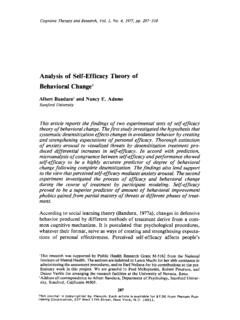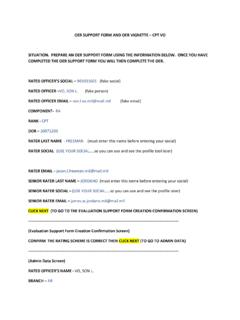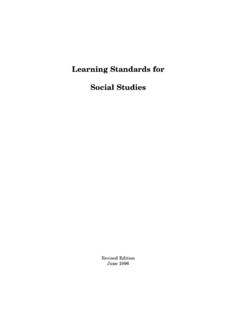Transcription of The Budgeting Process - Harbor Creek School District
1 1 The following information was adapted from Pennsylvania Department of Education s Manual of Accounting and Financial Reporting for Pennsylvania Public Schools The Budgeting Process The annual general fund budget is one of the most important legal documents at your School and budget adoption is one of the most significant functions of the School board. The Board-approved budget presents expenditure appropriations, which may not be exceeded without an amendment. The general fund fiscal year budget must be adopted before expenditures may be made from that fiscal year. Without a Board-approved budget, the School has no new spending authority for that fiscal year. Adoption of the budget should also be done prior to setting the tax rate for the budget year. Presented herein is a typical budget Process for schools and a discussion about such important concepts as: Objectives Of Budgeting ; Legal Requirements; The Budget Cycle; Estimates; The Budgetary Reserve; and Forecasting and Planning.
2 Purpose And Procedure The Pennsylvania Public School Code requires all Local Educational Agencies (LEA) to prepare, present, and adopt an annual General Fund Budget. The budget is a financial plan prepared to estimate the revenue and expenditures required to achieve the educational programs of the School entity for the next fiscal year. Each School entity may also adopt other budget documents to govern all special revenue funds, proprietary funds; such as, cafeteria operations, and capital facilities. The capital budget will encompass not only the next fiscal year but also several future fiscal years. The budget document is essential to ensure the raising of revenues and expenditures of resources consistent with provisions of the constitutions, federal and state laws, statutes, court decisions, board decisions and administrative actions.
3 The budget, when adopted, is also the basis upon which tax rates are set. It is the legal document that places restrictions on amounts spent for stated purposes; it serves as an important management tool; and it can be an excellent public relations tool. A budget is an outline of educational programs and services with costs affixed to specific purposes to effectively direct the administration in achieving the LEA's goals and objectives. Formal budgets play a far more important role in the planning, control and evaluation of an LEA's operations than in those of the private sector. In schools, the adoption 2 of a budget implies that a set of decisions have been made by School board members and administrators which culminate in matching a School 's resources with its' operational needs.
4 The budget also provides an important tool for the control and evaluation of a School District 's sources and uses of resources. With the assistance of the accounting system, administrators are able to execute and control the activities that have been authorized by the budget and evaluate performance based upon comparisons between budgeted and actual operations. In the educational context, Budgeting is a valuable tool in both planning and evaluation processes. Budgeting provides a vehicle for translating educational goals and programs into financial resource plans. Thus, planning to meet student educational requirements and goals should be the basis for determining budgetary allocations. This link between instruction and financial planning is critical to effective Budgeting .
5 In addition, such a Budgeting practice will enhance the evaluation of budgetary and educational performance since resource allocations are closely associated with instructional plans. In this way, the annual general fund budget is not only the financial plan, but also the educational plan expressed in dollars. GASB Codification states, "The annual budget authorizes, and provides the basis for control of, financial operations during the fiscal year. This is the type of budget recommended, whether or not required by law, and that should be appropriately controlled through the accounting system to assure effective budgetary control and accountability." The preparation and Board review Process for an annual budget must be conducted and completed prior to the commencement of each new fiscal year.
6 Section 687 of the Public School Code of 1949 requires the adoption of the budget and the necessary appropriation measures required to put it into effect. Section 687 also requires proposed budgets to be prepared at least 30 days prior to the adoption of the annual budget. Budgets should be prepared on a basis consistent with the basis of accounting used by the LEA. Without a Board-approved annual budget, the School has no new spending authority for that fiscal year. OBJECTIVES OF Budgeting The purpose of Budgeting is to provide the best possible educational opportunities for every student in an educational institution. Budgets should also reflect the administration's ability to manage the financial affairs of the School . Budgets are required to: Be balanced so that current revenues are sufficient to pay for current services; Be prepared in accordance with all applicable federal, state and local legal mandates and requirements; and Provide a basis for the evaluation of the School 's service efforts, costs and accomplishments .
7 BUDGET Process OVERVIEW The Budgeting Process is comprised of three (3) major phases: planning, preparation and evaluation. The budgetary Process begins with sound planning. Planning defines goals and objectives for the LEA's administration and support services and develops programs to attain those goals and objectives. Once these programs and plans have been established, budgetary resource allocations are made to support them. Budgetary resource allocations are the preparation phase of Budgeting . The allocations cannot be made, however, until plans 3 and programs have been established. Finally, the budget is evaluated, after the close of the year, for its effectiveness in attaining the LEA's goals and objectives. Evaluation typically involves an examination of how funds were expended, what outcomes resulted from the expenditure of these funds, and to what degree the outcomes achieved the objectives stated during the planning phase.
8 This evaluation phase is important in determining the following year's budgetary allocations. In summary, budget preparation is not a one-time exercise to determine how a School entity will allocate funds. A School entity's budget preparation is part of a continuous cycle of planning and evaluation to achieve the School 's goals. Legal Requirements For Budgets Pennsylvania Public School Code LEA Section 687 School Districts 2nd, 3rd, and 4th Class Section 918-A Intermediate Units, Summary and Program Budgets Section Area Vocational Technical Schools Title 50, Mental Health, 4201(5) of the Pennsylvania Public School Code requires an annual budget from intermediate units for State-Funded Early Intervention Programs. Each Section of the Pennsylvania Public School Code listed above mandates specific procedures in completing budgets for each type of School entity.
9 Section 687 requires: annual budgets from 2nd 3rd and 4th class School districts; a proposed ensuing year budget at least 30 days prior to adoption of the annual budget on a form provided by the PDE. This budget presents estimates at the service area, major object category, however, many School entities budget to a much greater detail level and may choose to present a more detailed budget to the School board and public; public notice must be given at least ten (10) days before any final action is taken on the ensuing year's budget; a proposed budget must be made available to the public for inspection at least twenty (20) days before the School board plans to meet and vote on adopting the budget; and a final adopted budget must be filed with the PDE within fifteen (15) days of board adoption on PDE prescribed forms.
10 Section 687 also: Prohibits deficit financing; that is, the total amount of the budget may not exceed the amount of funds available for School purposes, including the proposed annual tax levy and State appropriations. Appropriations and reserves must be equal to or less than the fund balance and all estimated revenues available for the budget year. 4 Allows unencumbered balances to be transferred from one budget category to another during the last nine (9) months of the fiscal year while prohibiting transfers during the first three (3) months. Prohibits funds not appropriated in the budget from being unavailable throughout the year unless placed in budgetary reserve in the original budget. Allows the board to change the budget to accommodate emergencies such as epidemics, floods, fire or other catastrophes.









